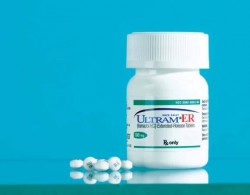Types of Help Available for Ultram Addiction
Chronic pain is a problem for millions of Americans today. Unfortunately, the most effective treatments for chronic pain are addictive. Some of these are more addictive than others. One of the least addictive chronic pain treatment medications is Ultram. Even though it is often represented as a nonaddictive pain treatment, there are reports of people becoming dependent on it and then going through withdrawal. Like any opioid addiction, Ultram addiction sometimes requires treatment. There are a few different treatment types available.
What is Ultram and Ultram Addiction

Ultram is a prescription pain medication.
Ultram one of the newer prescription pain relievers for chronic pain. Up until recently, Ultram was thought to be as safe as other opioid pain relievers are but in a 2009 fax sent to Johnson and Johnson, the manufacturer from the Department of Health and Human Services, serious dangers were noted. This makes the use of Ultram far less desirable than it was. Some of the dangers outlined in the fax are:
- carries the same risks as other opioids when mixed with alcohol or other pain relievers,
- may cause seizures,
- may cause suicide,
- risk of developing serotonin syndrome,
- interacts with other central nervous system depressants,
- increased chance of intracranial pressure,
- causes withdrawal symptoms, and
- is as addictive as most of the other opioid pain relievers and narcotics.
Previously thought to be less addictive than other narcotics, it in fact carries the same risks as any other opiate or opioid.
Ultram withdraw is similar to other narcotics as well. These withdrawal symptoms are:
- anxiety,
- mood swings,
- irritability,
- shock like tingling,
- tremors,
- headaches,
- shivering,
- sleeping difficulties such as insomnia or nightmares,
- flu-like symptoms,
- stomach upset such as nausea, vomiting, and diarrhea,
- hallucinations or unusual thinking, and
- aggression and irritability.
Whole hosts of side effects that persist even after stopping Ultram accompany these withdrawal effects. Stopping Ultram abruptly can cause serious consequences. This is why it is best to seek treatment rather than just stopping it suddenly.
Treating Ultram Addiction
There are four basic types of Ultram addiction treatment. Each type has its own pros and cons. The type of treatment you choose will depend on your individual preferences and needs. Carefully compare each type to find the treatment that works best for you. The four types are inpatient, outpatient, combination, and home treatment.
- Inpatient Ultram withdrawal treatment – During inpatient treatment, the patient stays at a treatment facility. Counselors, support staff, and medical staff care for those in treatment.
o The advantages of inpatient treatment are:
- 24/7 care and supervision,
- Onsite counseling and therapy,
- Some offer holistic treatment,
- Onsite medication management,
- Away from any triggers and possible temptation to take it,
- Medications for chronic pain or other conditions that started the Ultram addiction,
- Possibility of opiate replacement medications, and
- Peer support.
o The disadvantages of inpatient treatment are:
- You are not allowed to leave the restrictive environment,
- Leave work and school for up to 90 days,
- Away from family and friends,
- Higher cost due to sleeping quarters and meals,
- Outpatient Ultram withdrawal treatment – This form of treatment requires you to go to a clinic or doctor to receive treatment. This can be daily, weekly, or monthly.
o The advantages to outpatient treatment are:
- Freedom to come and go as you please,
- Support from family and friends,
- Lower cost than inpatient treatment,
- More flexible treatment,
- Patient can add or subtract different treatments, and
- Medications for pain and opiate replacement may be given by a doctor.
o The disadvantages of outpatient treatment are:
- Patient is around the triggers and circumstances that can cause relapse,
- No access to counselors during the night or possibly on weekends,
- Less structure sometimes means less success, and
- Not as much peer support and understanding.
- Combination Ultram withdrawal treatment – This type of treatment involves a combination of inpatient (usually for detox) and outpatient treatment (usually for counseling and medication management.) As the name suggests this treatment combines the advantages and disadvantages of both the previous types of treatment.
o Specific advantages of combination treatment are:
- Best of both inpatient and outpatient treatment,
- Choice between remaining in one or the other,
- Shorter time in inpatient treatment, and
- Learn how to deal with triggers and then apply that knowledge sooner than just inpatient treatment.
- Home treatment for Ultram withdrawal – home treatment involves detoxing and learning how to deal with the addiction without any medical or psychological help. Although it is possible, it is not recommended. Many of the effects of withdrawal can become dangerous if left unattended.
o Advantages of home treatment:
- Inexpensive,
- Private, and
- Family and friends can provide a support system.
o Disadvantages of home treatment:
- More difficult,
- Easier to relapse,
- No medical help,
- Doesn’t treat the cause of the addiction,
- May be dangerous, and
- Can cause other problems.
Regardless of which type of Ultram addiction treatment you choose, if you think you are addicted it is best to consult a doctor about the addiction. It is possible to become addicted to Ultram without taking it excessively or recreationally. Many of the people who take it wind up going through withdrawal after a normal course of it. According to the National Institute on Drug Abuse, a combination of psychotherapy and medication works best for this type of addiction. This combination is found in inpatient, outpatient, and combination treatment.












